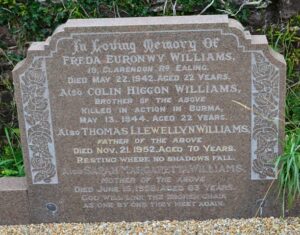Lampeter Velfrey sits in a lovely location, about four miles west from Whitland, and three miles from Narberth, over the County border in Pembrokeshire. The War Memorial is in the form of a Celtic Cross, and was unveiled by Private Phil Davidson, who had served in Palestine and France with the 24th Welsh. The World War Two Plaque was obviously a later addition. Some of these men are commemorated on the War Memorials of nearby Narberth and Whitland. There are also several individual memorials in the Church, including two to local men who fell during the Boer War, so these men are also commemorated below.
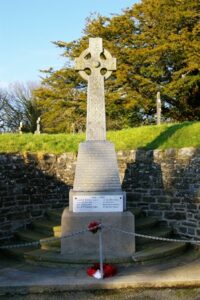
The Boer War, 1899-1902
William James Jacobs, Private, 5892, 1st Battalion, Royal Welsh Fusiliers. William was the son of David and Elizabeth Jacobs, of Middleway Farm, Cyffig, Whitland. He died of enteric fever at Ladysmith on 28 April 1900, aged 17. He is buried at Thornhill, Ladysmith. His brother, Arthur George Jacobs, was killed in WW1. George is commemorated on his parents headstone in Lampeter Velfrey Churchyard.
Ralph Paynter Williams, Farrier Sergeant 4138, 30th (Pembrokeshire) Company, 9th Battalion, Imperial Yeomanry. Ralph was born at Pembroke on 13 December 1879, the son of Reverend David Edward Williams, and Mrs Rose Williams (nee Paynter), of Lampeter Velfrey. He was educated at Haileybury, Hertfordshire and Royal Veterinary College. He then joined the Royal Army Veterinary Corps, but at the outbreak of the Boer War, volunteered for service with the Pembroke Yeomanry. He was just 21 years old when he was killed in action near Ventersburg while attempting to rescue an officer on 23 August 1900. He is buried in Ventersburg Cemetery,Ventersburg. Ralph is commemorated by a stained glass window inside the Church.

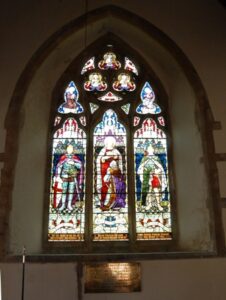
The Great War, 1914-1918
Edward Arnold Frederick Allen, Private, 6386, Royal Fusiliers. Edward was born at Foochow, China, the son of Edward Launcelot Baugh Allen and Blanche Adelaide Allen, of Blackhaldern, Narberth. He enlisted into the 10th Battalion, Royal Fusiliers, which were attached to 54 Brigade, 18th (Eastern) Division. The 10th RF were also known as the Stockbrokers Battalion, due to their main bulk being made up of City businessmen. They transferred to 111 Brigade, 37th (London) Division before moving to France at the end of July 1915, and saw their first major attack during the attack on Gommecourt, which was a diversionary attack for the main Somme Offensive. During the first couple of days of the Somme Offensive, another Division, the 34th, had suffered terrible casualties, and so Edward was transferred to the 34th Division temporarily, along with the other men of 111 Brigade. They then fought at the Bazentin, Pozieres and Flers-Courcelette, before returning to their own Division, when they fought at the Battle of the Ancre. Edward was wounded at the Ancre, and was transferred to the 11th Casualty Clearing Station at Varennes, where he Died of Wounds aged just 22 on 21 November 1916. Edward is buried at Varennes Military Cemetery, France. There is also a memorial to him in the cemetery, but I did not know of it when I visited.
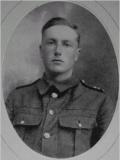
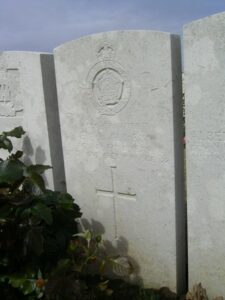
Harry Montague Allen, Private, 20965, Welsh Regiment. Harry was born in Prendergast, Haverfordwest, in 1896, the eldest son of Thomas and Edith Allen. Thomas had been born in Amroth, and his wife Edith in Haverfordwest, and they had four other children. Ellen Allen, Frederick, Thomas and Edwin Jack Allen, who were born in Neyland. Thomas was a Plumber with Great Western Railway, and he was transferred to their Depot at Whitland, where the family made their home at 3, Glendale Terrace. Harry followed his father into the Railway, becoming a Carpenter at the Llanelli Depot. At the outbreak of War, Harry enlisted into the 15th Battalion, Welsh Regiment, which was the Carmarthenshire Battalion. The Battalion was first raised in Swansea during October and November, 1914, by the Carmarthenshire County Committee, attached to 129 Brigade, 43rd Division. The preliminary training of the battalion was carried out at Rhyl. From 28 April 1915 the Battalion became attached to 114 Brigade, 38th (Welsh) Division, part of K4. In the summer of 1915 the Battalion moved with the remainder of the Welsh Division to Morn Hill Camp, Winchester, where it completed its training and equipping, and embarked for France from Folkestone on 5 December 1915, disembarking at Boulogne the same day. During the winter and spring of 1916 the Battalion held nearly every section of the British line from Givenchy on the La Bassée Canal to Laventie, about six miles South of Armentières. At the end of May, 1916, the Battalion moved South with the remainder of the 38th (Welsh) Division to the Somme area, in readiness for the First Battle of The Somme, which commenced on 1 July 1916. The 38th Division were tasked with the taking of the infamous Mametz Wood. The first attack on Mametz Wood was on 7 July 1916, when the division lost heavily in ‘Death Valley’ during the advance on the ‘Hammer Head’. The next attack went in three days later, and after 48 hours of heavy fighting the wood was cleared – but at the cost of over 5,000 casualties in the 38th (Welsh) Division. It was during the first attacks on the wood that Harry Montague Allen was mortally wounded. He was shot in the chest by a German sniper, and brought back by rail to the 38th Casualty Clearing Station at Heilly, in the Somme valley. Harry died of his wounds on 11 July 1916, and was laid to rest in Heilly Station Cemetery, France.
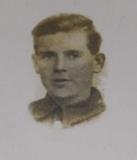
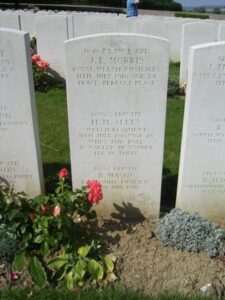
Lionel Raymond Whateley Allen, Lieutenant, South Wales Borderers. Lionel was the younger brother of Edward, and was also born in China, the son of Edward Launcelot Baugh Allen and Blanche Adelaide Allen, of Blackadern, Narberth. Lionel had received a commission and served in the 9th Battalion, South Wales Borderers, which had been founded at Pembroke Dock in October 1914 and was used as a Training Battalion. Lionel was attached to a Battalion of the Machine Gun Corps in France, but as yet the unit is unknown. He was reported as wounded during the German offensive near Bapaume on 27 March 1918, and was left behind while his unit was retiring under heavy fire. He was never seen again. Lionel was 21 years old, and is commemorated on the Pozières Memorial, France.

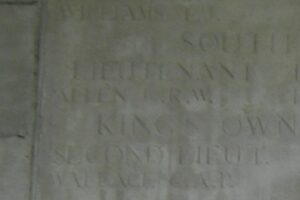
Richard Lancelot Baugh Allen, Lieutenant, Royal Field Artillery. Richard was born in Chelsea on 1 May 1886, the son of His Honour Judge Wilfred Baugh Allen and Annie Sophia Allen (nee Wedgwood), a member of the famed Wedgwood family. His parents later resided at Rosemount, Tenby, whilst Richard lived at Cilrhiw, Lampeter Velfrey. Richard followed his father into the legal profession, becoming a lawyer, and by 1914 was living in Canada. On 11 November 1914 he enlisted at Victoria, British Columbia, into the Canadian Mounted Rifles. He later received a commission into the Royal Field Artillery and married Marion Irvine whilst based in Preston, Lancashire on 12 June 1917. Richard was then posted to Egypt, joining the 67th Brigade, RFA, which was attached to the 13th (Western) Division and had moved there in early September 1917. On 3 February 1918 Richard was found guilty by Court Martial held at Kantara, after being found drunk on duty. He was obviously by now suffering from stress brought on by his war service, and committed suicide by shooting himself in the head with his revolver on the morning of 27 December 1918. Richard was 31 years old, and is buried at Cairo War Memorial Cemetery, Egypt.
James Beynon, Private, 13097, Welsh Regiment. James was born in Robeston Wathen, the son of Alfred and Sarah Beynon. The family later moved to Gorse Farm, Whitland. James enlisted at Carmarthen into the 2nd Battalion, Welsh Regiment, which formed part of 3 Brigade, 1st Division. The Division were one of the first to arrive in France, and fought during the epic retreat from Mons to the Aisne, where the German advance was stopped before moving to Ypres, where again they helped stop the Germans taking the ancient city. After a hard winter at Ypres, the Welsh fought at the Battle of Aubers, which was the first major Allied offensive of the war. James was Killed in Action here, on 3 May 1915 aged only 20. He is commemorated on the Le Touret Memorial, Richebourg-L’Avoue, alongside his cousin, James Verdi Davies.
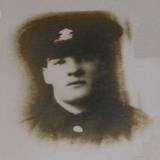
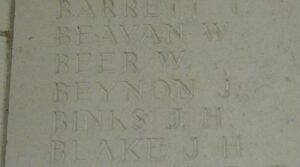
George William Henry Bodman, Private, 2060, Welsh Guards. George was born in Bath in 1885, the son of Frances Norah Bodman. His mother married Thomas William Chambers in 1901, and the family moved to 5, Velfrey Road, Whitland. George moved to Clive House, Tridwr Road, Abertridwr prior to the war, where he worked as a policeman. He enlisted at Cardiff into the newly formed Welsh Guards. The Welsh Guards were raised after the Royal Warrant of 26 February 1915. After being formed, they became part of the 3rd Guards Brigade, Guards Division, which was formed in France in August 1915. Their first taste of battle was at Loos, before being brought south to the Somme in 1916. During the Somme Offensive the Division fought at the Battle of Flers-Courcelette, and this is where George was Killed in Action on 16 September 1916, aged 31. George’s body was lost on the battlefield and never recovered, and so he is commemorated on the Thiepval Memorial.
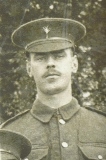
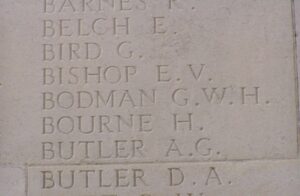
Cecil Frank Bye, Private, STK/923, Royal Fusiliers. Cecil was born at Lampeter Velfrey, the son of John and Sarah Ruth Annie Bye. The family later moved to the School House, Rotherwick, Basingstoke, Hants. Cecil enlisted in London into the 10th Battalion, Royal Fusiliers, which were also known as the ‘Stockbrokers Battalion’, which formed part of 111 Brigade, 37th Division. In late July, 1915 the Division landed in France, and moved to positions north of the Somme, at Gommecourt. They took part in a diversionary attack on Gommecourt on 1 July 1916 and suffered terrible casualties. 111 Brigade were then attached to the depleted 34th Division, and fought with them at the Battles of Albert and Bazentin Ridge, where Cecil was Killed in Action on 15 July 1916. He was 25 years old, and is commemorated on the Thiepval Memorial, Belgium. Cecil is not commemorated locally.
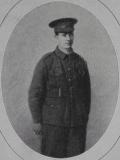
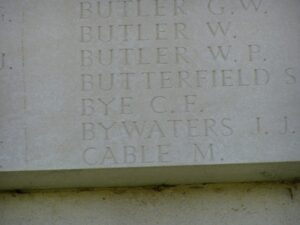
James Verdi Davies, Private, 13116, Welsh Regiment. James was born at Norton, Lampeter Velfrey, the son of James and Elizabeth Davies. The family later resided at Lowmead House, Whitland. He enlisted at Carmarthen into the 2nd Battalion, the Welsh Regiment which formed part of 3 Brigade, 1st Division. The Division were one of the first to arrive in France, and fought during the epic retreat from Mons to the Aisne, where the German advance was stopped before moving to Ypres, where again they helped stop the Germans taking the ancient city. After a hard winter at Ypres, the Welsh fought at the Battle of Aubers, which was the first major Allied offensive of the war. Here James fought alongside his friend James Beynon who he had enlisted with, and was Killed in Action just two weeks later, on 25 May 1915. James is commemorated alongside his cousin, James Beynon, on the Le Touret Memorial, France.
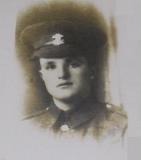
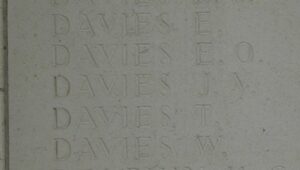
Arthur George Jacobs, Lance Corporal, 12338, Royal Welsh Fusiliers. George was born on 31 October 1887, the son of David and Elizabeth Jacobs, of The Lodge, Cyffig. He worked as a collier prior to the war and enlisted at Llanelli into the 8th Battalion, Royal Welsh Fusiliers, which formed part of 40 Brigade, 13th (Western) Division. The Battalion moved with the Division to the Mediterranean, arriving at Mudros by July 1915, before landing on Gallipoli that month. On Gallipoli the Division saw more than its fair share of fighting, taking part in the Battles of Sari Bair, Russell’s Top and Hill 60, before moving to Suvla Bay where it withheld the Turkish attacks on 7 January 1916. After evacuating to Egypt the Division moved to Mesopotamia, where they attempted the relief of Kut. George died of wounds in Mesopotamia on 26 January 1917, aged 29, and is buried at Amara War Cemetery. His brother William James Jacobs had died at Ladysmith during the Boer War.
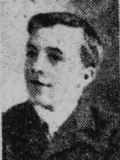
Herbert Benjamin Thomas Lewis, Corporal, 16292, Northamptonshire Regiment. Herbert was born in Lampeter Velfrey on 22 March 1879, the son of Robert and Mary Lewis, late of Waunfaur Farm. The family moved to Hackleton, Northampton, which is where Herbert enlisted into the 3rd Battalion, Northamptonshire Regiment on 31 October 1914. He transferred into their 2nd Battalion, part of 24 Brigade, 8th Division. Herbert arrived in France on 2 March 1915 and fought in the Battle of Neuve Chappelle, and was Killed in Action during the Battle of Aubers Ridge on 9 May 1915 aged 37. In a letter to Mary after the battle, his Lieutenant Haldane wrote: ‘I am sorry to say that details as to what happened on 9th May are very hard to get, but I do know that Herbert B T Lewis advanced with his company in the attack. They were the leading company, and he with many of his company members were caught with machine gun fire.’ Herbert is commemorated on the Ploegsteert Memorial, Belgium. He is not commemorated locally.
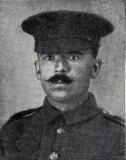
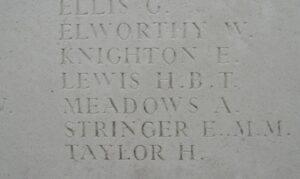
John Lloyd, Private, 101679, Canadian Pioneers. John Lloyd was born on 19 November 1873, the only son of Walter and Mary Lloyd, East Pool Farm, Eglwyscummin. He married Sarah Jane James of Crunwere in 1900 and the family eventually settled at Meline, Lampeter Velfrey. About 1910 John went to Alberta, Canada to work as a miner at a small, newly opened coal mine near Red Deer. On 22 February 1916 John enlisted at Edmonton, Alberta into the 66th Edmonton (Overseas) Battalion, and arrived in England on 7 May 1916. He was posted to 1st Canadian Pioneers and left for France on 5 July 1916. On 6 August 1916 he was posted to 1st Canadian Entrenching Battalion in the field. He paraded sick on 5 December 1916, suffering from exposure to shell fire on the Somme, and was hospitalised for 10 days with V.D.H. and epilepsy, before rejoining his unit. On 3 September 1917 John again reported sick at Vimy Ridge. He had severe pains in his legs and chest and was immediately sent back to base hospital. He had suffered with heart pain and palpitations for some months prior to this. After 12 days treatment at Etaples, John was evacuated to Bethnal Green Hospital for 12 days, then Bromley for 10 days, Buxton 2 months, and to Liverpool for 5 weeks. He then returned to Wetaskiwin, Alberta, Canada, where he received further treatment before being discharged from the service on 17 August 1918, with the intention to live at the GWVA (veterans home) in Edmonton. Sadly John died on Armistice Day, 11 November 1918. He is buried at Lovett, Alberta, Canada. With the help of the ladies of Llanteg History Society I have managed to gain commemoration for John by the CWGC and a new headstone has been erected for him at Lovett.
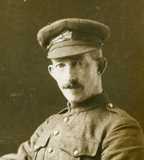
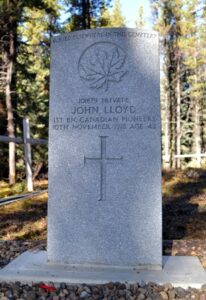
Levi Oliver Morgan, Private, 10180, Royal Welsh Fusiliers. Levi Oliver Morgan was born at Penllan, Lampeter Velfrey in 1879, the son of John and Elizabeth Morgan. For some reason, Levi then changed his name to David, and enlisted at Pembroke into the Army, and served as a regular with the 1st Battalion, Royal Welsh Fusiliers. The 1st RWF was stationed in India at the outbreak of war, and was recalled to England, where it was placed in 22 Brigade, 7th Division. The Division was formed during September 1914 and landed at Zeebrugge on 6 October 1914. The City was already falling however, and so the Division was moved to Ypres, where it became the first British Division to hold the city. Here the Division took the full brunt of a renewed German assault, intended to drive across Belgium and to occupy the Channel Ports, thus stopping the British from sending troops to France. The First Battle of Ypres opened on 19 October 1914, when a strong German force attacked the British positions at Langemarck and Gheluveldt. The 1st RWF took heavy casualties during the ensuing fighting, but the superior training of the British regular soldier helped them to hold their lines against a vastly superior, but young and less well trained, German force, resulting in the battle being known as the ‘Kindermord bei Ypern’, or the ‘Massacre of the Innocents.’ Sadly, David was killed in action here on 20 October 1914. He was 35 years old. David was buried on the battlefield, but as the fighting at Ypres continued unabated over the ensuing years, his grave, as with so many others, was lost, and today David is commemorated on the walls of the Ypres (Menin Gate) Memorial.
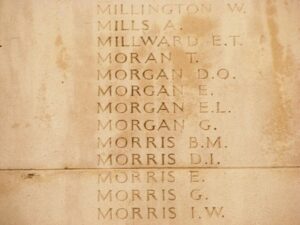
William John Phillips, Private, 53991, Welsh Regiment. William was born at Blaengwaith Noah, Lampeter Velfrey, the son of David and Elizabeth Phillips, later of 5, Slade Lane, Haverfordwest. William had enlisted at Narberth into the 16th Battalion, Welsh Regiment, which was attached to 115 Brigade, 38th (Welsh) Division. The Division landed in France in December, 1915 and moved to positions in ‘The Nursery Area’ near Armentieres. After several months here, they moved south in June, 1916 to take part in the Battle of the Somme. Their task was to capture the formidably fortified Mametz Wood. The first attack went in on the 7 July 1916, but was repelled with heavy casualties, and it was almost a week later that the Wood fell. The terrible casualties incurred by the Division here forced them to be pulled from the line, and moved north to Ypres to rebuild. It was at Ypres that the Division took part in the Battle of Third Ypres, or Passchendaele. The Welsh fought at the Battles of Pilckem Ridge, and at Langemarck, where William was Killed in Action on 27 August 1917 aged just 19. He is commemorated on the Tyne Cot Memorial.
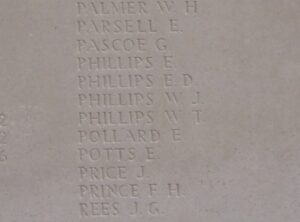
David Pugh, Lance Corporal, 3278, South African Expeditionary Force. David was the son of David and Sarah Pugh, of Clover Hill Farm, Velfrey Road, Whitland. He had served during the Boer War of 1899 to 1901, and had remained in South Africa afterwards, working for the head office of the South African Railways at Cape Town. He re-enlisted on 17 August 1915 for service in the South African Overseas Expeditionary Force. David joined the 4th (Scottish) South African Infantry Regiment, which was assembling with the South African Brigade, in Egypt. During March 1916 the Brigade embarked for Marseilles, and became attached to the 9th (Scottish) Division, situated near Bailleul. The South Africans trained in trench warfare over the coming weeks, before the 9th Division moved south, to the Somme, in June. On 30 June the South African Brigade moved to Grove Town, south of Albert, where it watched the opening of the Battle of the Somme on 1 July. On the following night the South Africans entered the front line north-west of Maricourt, and spent the coming days holding the trenches against German artillery fire. On Monday 10 July 1916, the 4th South African Regiment attacked Trones Wood, in support of the 30th Division, but came under heavy artillery fire. David was killed during fighting on the southern edge of Trones Wood on 10 July 1916, aged 42. He has no known grave, and is commemorated on the Thiepval Memorial, France.
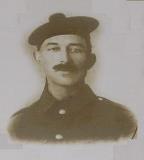
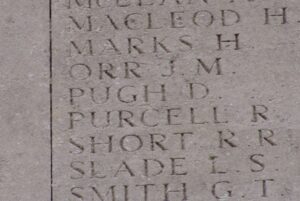
Albert Gwynne Thomas, Private, 28305, Royal Dublin Fusiliers. Albert was born on 14 April 1896, the son of William and William and Martha Thomas, of Carvan Lodge, Tavernspite. He initially served with the Queen’s Regiment before being transferred to the 6th Battalion, Royal Dublin Fusiliers, which had seen service at Gallipoli with the 10th (Irish) Division. The battalion had then served in Salonika before being transferred to France in July 1918 and on 21 July 1918 transferred to 197 Brigade, 66th (2nd East Lancashire) Division. Albert served with the battalion in France, taking part in the great 100 days offensive which won the war. The war took a heavy toll on his health and he died in hospital in Neath on 6 March 1923, aged 26. He is buried in Carvan Chapelyard, where his grave is marked by a shield ‘From His Comrades at Crunwere 1914-1918’. Albert is not an official war casualty and is not commemorated on the Lampeter Velfrey memorial.
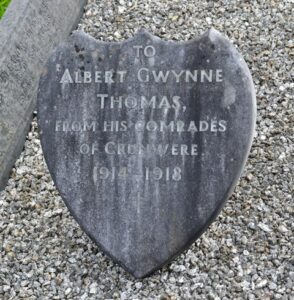
Levi Thomas, Private, 8226, South Wales Borderers. Levi was the son of Daniel and Jane Thomas, of Plasnewydd, Whitland, and enlisted at Pontypridd into the 2nd Battalion, South Wales Borderers, part of 87 Brigade, 29th Division. The 2nd SWB had a very interesting war to say the least. They were based in Tientsin in China at the outbreak of war, where they aided the Japanese army to force the German garrison from Tsingtao. They embarked from Hong Kong on 4 December 1914 for Plymouth. Once back on British soil, they joined 87 Brigade, 29th Division at Rugby, and this is where Thomas Jackson joined his Battalion. On 17 March 1915 they sailed from Avonmouth on the SS Canada for Alexandria, and on 25 April 1915 they landed at Gallipoli. Levi was Killed in Action during the landings on Gallipoli that Day. He was 30 years old, and is commemorated on the Helles Memorial, Gallipoli.
Daniel John Williams, Second Lieutenant, Machine Gun Corps. Daniel was born in 1883, the son of Joseph and Mary Williams of Cwmtwrch, Swansea. He married in 1907, and by 1911 was residing with his wife Annie Williams at Lampeter View, Lampeter Velfrey. Daniel was at the time the Headmaster at the Lampeter Velfrey Council School, then moved to Blaenconin Council School. Just prior to the war, he had moved with Annie to 93, Endelsham Road, Balham, London, and was an assistant master at a local school. Daniel enlisted in London into the 18th Battalion, Royal Welsh Fusiliers, and was soon commissioned as Second Lieutenant into the 13th Battalion, Machine Gun Corps, which was attached to the 13th (Western) Division. Daniel was killed in action during the Battle of Passchendaele on 5 October 1917, aged 35. He has no known grave, and is commemorated on the Tyne Cot Memorial, Belgium. Daniel is not commemorated locally.
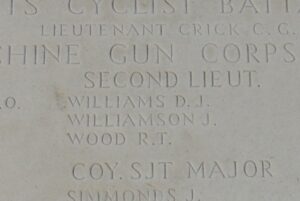
David Arthur Williams, Private, 45980, South Lancashire Regiment. David was born at Ivy Cottage, Lampeter Velfrey, the son of John and Ruth Williams. The family later resided at Coxlake, Narberth, and David enlisted there into the army. He was posted to the 4th Battalion, South Lancashire Regiment, which was a reserve battalion. During April 1918 the battalion moved to Dublin, after the outbreak of violence there by IRA loyalists. David wasn’t in Ireland for long though, as within weeks he had been hospitalised at Cork Street Hospital, where he died on 29 June 1918, aged just 18. David was brought home, and was buried at Lampeter Velfrey (Bryn Sion) Congregational Chapelyard.
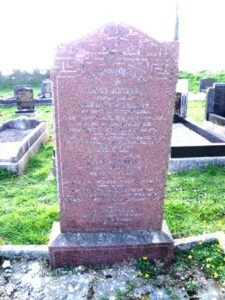
World War Two, 1939-1945
Dalis George Davies, Pilot Officer, 48776, Royal Air Force Volunteer Reserve. Dalis was the son of Benjamin and Annie Davies, of Whitland. Dalis was sent to Canada to undergo Pilot training, through the British Commonwealth Air Training Plan and joined No. 33 Elementary Flying Training School, Caron. This scheme in Canada produced thousands of well trained aircrew, more than enough to keep the various air forces of the Commonwealth supplied with men throughout the course of the war, but thousands died whilst training in Canada. Dalis was killed during a training accident on 8 September, 1942, aged 24. He is buried at Caron Municipal Cemetery, Ontario.
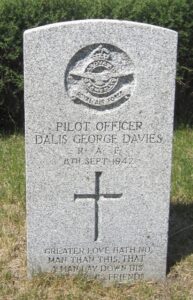
Thomas Eric Davies, Leading Aircraftman, 1832131, Royal Air Force Volunteer Reserve. Thomas was the son of John Albert and Mary Davies of Lan Mill, Narberth. Not much is known of him, but he enlisted into the Royal Air Force Volunteer Reserve. Thomas was based near Stratford-upon-Avon when he drowned whilst swimming in the River Avon on 6 July, 1943 aged only 19. He is buried at Lampeter Velfrey, in Bryn Sion Congregational Chapelyard.
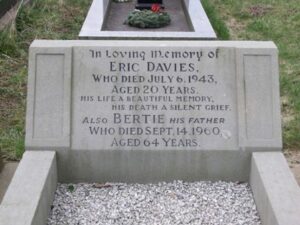
Gilbert Ronald Lewis, Sergeant, 980451, Royal Air Force Volunteer Reserve. Gilbert was the son of Joseph Walter Lewis and Elizabeth Mabel Lewis (nee Davies), of Manchester House, Lampeter Velfrey. He had enlisted into the Royal Air Force Volunteer Reserve, and was posted to 236 Squadron. On 31 October 1939, No 236 Squadron reformed at Stradishall in Fighter Command and received Blenheim fighters in December. It moved to North Coates at the end of February 1940 to join Coastal Command, but reverted to Fighter Command in April on arrival at Speke. During May and June the squadron flew defensive patrols over shipping in the English Channel and on 4 July rejoined Coastal Command for fighter and reconnaissance duties. A detachment was based in Northern Ireland from 18 September, which became No.272 Squadron on 19 November, but the bulk of the squadron’s operations were flown from Cornwall and Pembrokeshire until 9 February 1942, when it moved to East Anglia and became a cadre unit, its Beaufighters having been withdrawn from service with other squadrons. It became operational again on 15 March with Beaufighters, which it used for escort and shipping reconnaissance missions. In July 1942 it began taking part in attacks on enemy shipping off the Dutch coast, while detachments flew patrols over the Bay of Biscay to protect Coastal’s anti-submarine aircraft from enemy fighters. Gilbert was Killed in Action during one such raid, on 24 July 1942 aged 25. He is commemorated on the Runnymede Memorial, Surrey.
David Parry Thomas, Fusiliers, 4097613, Royal Welch Fusiliers. David was the son of John Thomas and Esther Thomas (nee Rowlands), of 14, Velfrey Road, Whitland. He served in the 1st Battalion, Royal Welch Fusiliers, which was posted to the Far East in March 1942 to serve in the campaign against the Japanese in India and Burma. At the end of the War in the East, the RWF moved back to India on Garrison duties, and David died in India on 9 December 1945 aged 28. He is buried in Kirkee War Cemetery.
Colin Higgon Williams, Private, 7947010, Leicestershire Regiment. Colin was born in Pontardawe in 1922, the son of Thomas Llewellyn Williams and Sarah Margaretta Williams (nee Higgon). Both his parents were from Lampeter Velfrey, but had moved as a result of his fathers job as a clerk of works for a building company. By 1939 the family was living in 19, Clarendon Road, Ealing and Colin enlisted there into the army. He was posted to the 7th Battalion, Leicestershire Regiment, which had been formed in July 1940, attached to the 205th Independent Infantry Brigade. In September 1942 the battalion was sent to India, and in 1941 joined the Chindits, taking part in the second Chindit expedition, codenamed Operation Thursday. Colin was killed in Burma during this operation, on 13 May 1944, aged 22. He has no known grave and is commemorated on the Rangoon Memorial, Myanmar. Colin does not appear to be commemorated locally, although he is commemorated on his parents grave at Carvan Chapelyard.
